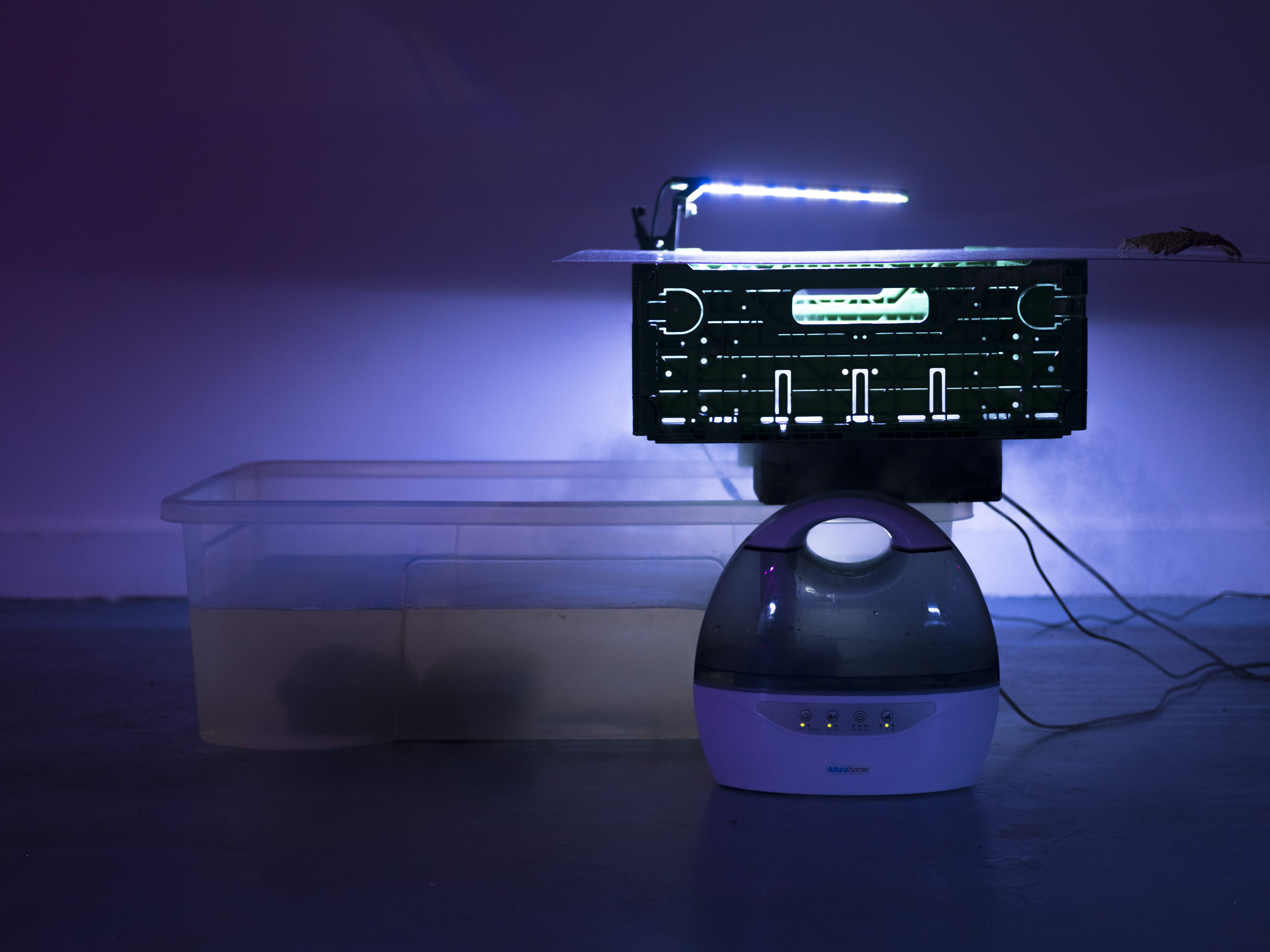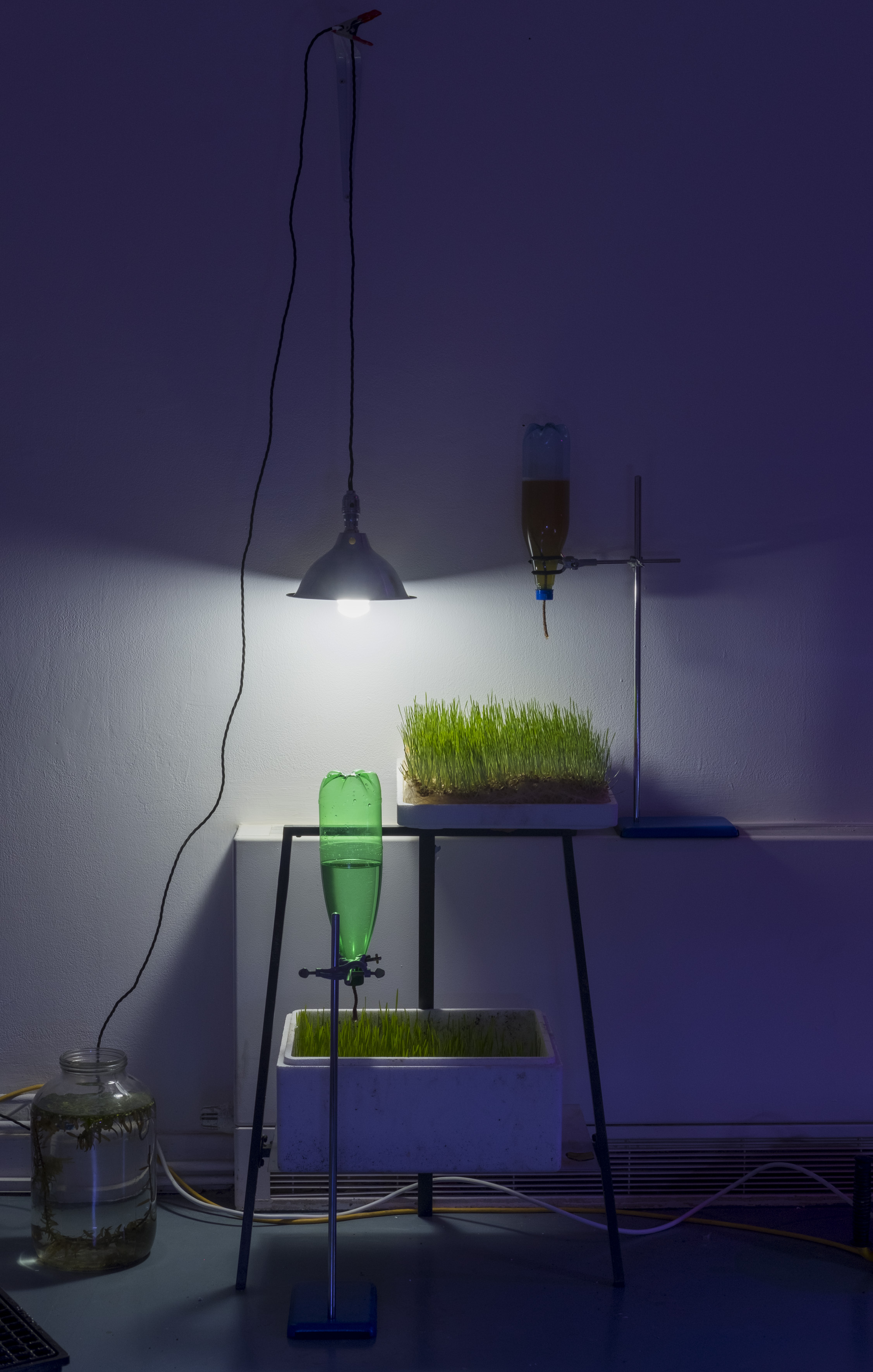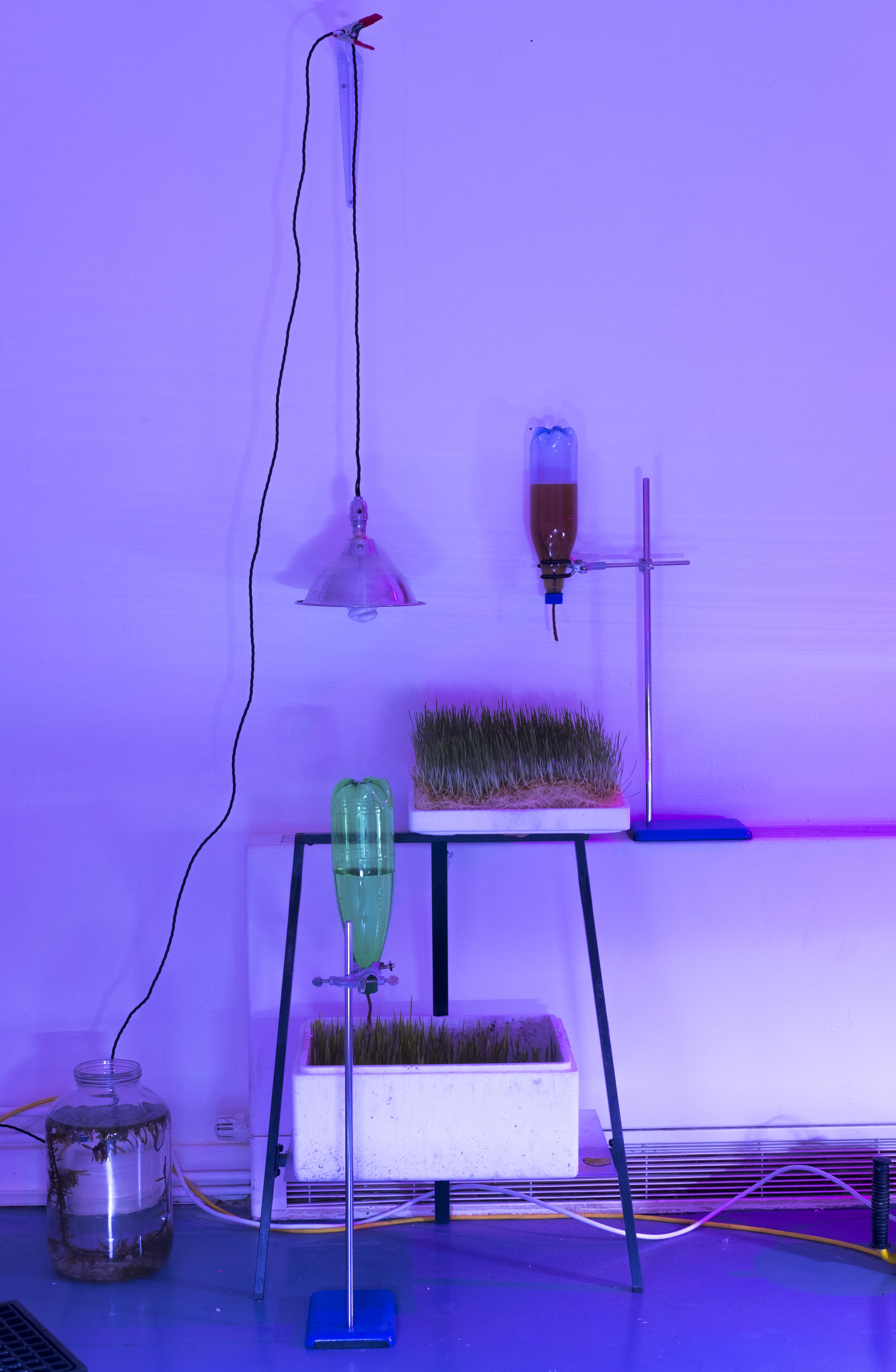Oikos Logos
Collabrative Project with Hannah Rowan, Gregory Herbert and Matthew Verdon
Curated by William Noel Clarke
The term ecology derives itself from the Greek words Oikos (household) and Logos (study), translating as ‘the study of the household’. Oikos Logos has activated Enclave Lab as a festivalistic laboratory departing from the traditional static exhibition structure and instead favouring real-time testing of theory with practice in a residency environment. The festivalistic Laboratory, as a curatorial methodology, is alternative to spectacle by encouraging participation and play to create edutainment value whilst promoting non-violence towards all living things through self-management, coexistence and co- survival. Split into two parts, Enclave Lab has first become a laboratory, in which the artists have taken residence for the past 3 weeks, and secondly an exhibition space where there aren’t singular works, but instead a mapping of an idea.
![]()
![]()
![]()
![]()
Jacob Von Uexküll, the father of modern zoology, proposed the term umwelt to describe his findings of closed worlds overlaid on the Earth. His dehumanization of nature combined with the studying of what Anna Tsing would call ‘polyphonic assemblages’ in an ecological community of multi-specie worlds, birthed a radical reconfiguring of Darwinian hierarchies that were then thought to be the natural order.
Tsing and Donna Haraway, have furthered Uexküll’s thinking to try and form an ecological post-anthropocentric position that has roots within the arts, politics and the social, considering the term Anthropocene as inadequate when addressing the Earth as a shared space of all organisms. Anna Tsing, an American anthropologist, questions in her book The Mushroom at the End of the World: On the Possibility of Life in Capitalist Ruins (2015) at what point does a gathering becomes a happening when species act upon each other drawing “one world making project into the other”. We are aware that multispecies alliances already occur without humans in the symbiosis of the Earth and we are now learning how to be included in this, sewing together our stories to the Earths. Human influenced ecologies can create new environmental networks by mutualisticly transferring material horizontally; we provide technological assistance to coral growth so they can reproduce faster to combat human caused coral bleaching, providing a life source for many of the oceans creatures. We could think of humans a becoming fluid component of the Earths mesh, even if we aren’t necessary to its survival; we are a node, a paranode and a communication link. Another of Tsing’s notions if that of a ‘contamination as collaboration’. Can human contamination of the Earth’s environments, ecology’s and creatures become some form of collaboration? A Post-nature?
![]()
![]()
![]()
Human influenced ecologies can create new environmental networks by mutualisticly transferring material; we provide technological assistance to coral growth so they can reproduce faster to combat human caused coral bleaching, providing a life source for many of the oceans creatures. We could think of humans as becoming a fluid component of the Earth’s mesh, even if we aren’t necessary to its survival; we are a node, a paranode and a communication link. The strange stranger, which Timothy Morton suggests is an uncanny ‘arrivant’ in a space where no one is sure who is who or what is what highlights the interconnectedness of this mesh. It is a blended ecotone, where two ecologies meet and all life forms act upon each other, rendering it difficult to distinguish one from another. The mesh, Morton suggests, is a more suitable word to describe natural networks as they are beyond concept as something that can be both the holes in a network and the threading between them.
Materials list;
Activated carbon pellets
Activated growing substrate
Air stones
Aquarium heaters
Bottles, glass
Bottles, plastic
Bricks with seaweed, River Thames
Bucket
Bungee cord
Burette stands
Cable ties
Canned plant growth CO2 & applicator
Clamp clips
Clamps, bar
Clamps, C
Clamps, G
Compost
Cooler boxes
Crates
Culture, Chlorella
Culture, Spirulina
Digital thermometers
Drawer divider
Electrical cables
Fish bowls
Flexible hoses
Floral foam bricks
Food containers
Funnel
Geotextile
Green tea
Growbulbs
Growth medium
Hemp rope
Humidifier
Jars, glass
Jars, plastic
Laboratory flask
Lights, aquarium
Lights, clamp
Lights, clip
Lights, growlight
Magnifying glass
Magnifying glass with alligator clips
Mesh bags
Moss balls
Moss, Deptford Creek
Moss, River Thames
Mud, Deptford Creek
Mud, River Thames
Mudlarking finds, River Thames, bones
Mudlarking finds, River Thames, ceramic fragments
Mudlarking finds, River Thames, glass fragments
Mudlarking finds, River Thames, log
Mudlarking finds, River Thames, rusted nails
Mudlarking finds, River Thames, smoking pipe fragments
Plants, pet store
Plants, Deptford Creek
Plants, River Thames
Plexiglass
Pumps, air
Pumps, water
Rocks, River Thames
Rod
Seaweed iodine supplements
Sticks
Storage boxes
Timer switches
Trays
Tressles
Underground access chamber base with fixed inlets
Underground bottle gully
Underground drainage socket bends
USA - UK plug adapter
Vase
Water, Deptford Creek
Water, River Thames
Water, tap
Wheatgrass
Xanthoria parietina, Maritime Sunburst lichen
Collabrative Project with Hannah Rowan, Gregory Herbert and Matthew Verdon
Curated by William Noel Clarke
The term ecology derives itself from the Greek words Oikos (household) and Logos (study), translating as ‘the study of the household’. Oikos Logos has activated Enclave Lab as a festivalistic laboratory departing from the traditional static exhibition structure and instead favouring real-time testing of theory with practice in a residency environment. The festivalistic Laboratory, as a curatorial methodology, is alternative to spectacle by encouraging participation and play to create edutainment value whilst promoting non-violence towards all living things through self-management, coexistence and co- survival. Split into two parts, Enclave Lab has first become a laboratory, in which the artists have taken residence for the past 3 weeks, and secondly an exhibition space where there aren’t singular works, but instead a mapping of an idea.




Jacob Von Uexküll, the father of modern zoology, proposed the term umwelt to describe his findings of closed worlds overlaid on the Earth. His dehumanization of nature combined with the studying of what Anna Tsing would call ‘polyphonic assemblages’ in an ecological community of multi-specie worlds, birthed a radical reconfiguring of Darwinian hierarchies that were then thought to be the natural order.
Tsing and Donna Haraway, have furthered Uexküll’s thinking to try and form an ecological post-anthropocentric position that has roots within the arts, politics and the social, considering the term Anthropocene as inadequate when addressing the Earth as a shared space of all organisms. Anna Tsing, an American anthropologist, questions in her book The Mushroom at the End of the World: On the Possibility of Life in Capitalist Ruins (2015) at what point does a gathering becomes a happening when species act upon each other drawing “one world making project into the other”. We are aware that multispecies alliances already occur without humans in the symbiosis of the Earth and we are now learning how to be included in this, sewing together our stories to the Earths. Human influenced ecologies can create new environmental networks by mutualisticly transferring material horizontally; we provide technological assistance to coral growth so they can reproduce faster to combat human caused coral bleaching, providing a life source for many of the oceans creatures. We could think of humans a becoming fluid component of the Earths mesh, even if we aren’t necessary to its survival; we are a node, a paranode and a communication link. Another of Tsing’s notions if that of a ‘contamination as collaboration’. Can human contamination of the Earth’s environments, ecology’s and creatures become some form of collaboration? A Post-nature?



Human influenced ecologies can create new environmental networks by mutualisticly transferring material; we provide technological assistance to coral growth so they can reproduce faster to combat human caused coral bleaching, providing a life source for many of the oceans creatures. We could think of humans as becoming a fluid component of the Earth’s mesh, even if we aren’t necessary to its survival; we are a node, a paranode and a communication link. The strange stranger, which Timothy Morton suggests is an uncanny ‘arrivant’ in a space where no one is sure who is who or what is what highlights the interconnectedness of this mesh. It is a blended ecotone, where two ecologies meet and all life forms act upon each other, rendering it difficult to distinguish one from another. The mesh, Morton suggests, is a more suitable word to describe natural networks as they are beyond concept as something that can be both the holes in a network and the threading between them.
Materials list;
Activated carbon pellets
Activated growing substrate
Air stones
Aquarium heaters
Bottles, glass
Bottles, plastic
Bricks with seaweed, River Thames
Bucket
Bungee cord
Burette stands
Cable ties
Canned plant growth CO2 & applicator
Clamp clips
Clamps, bar
Clamps, C
Clamps, G
Compost
Cooler boxes
Crates
Culture, Chlorella
Culture, Spirulina
Digital thermometers
Drawer divider
Electrical cables
Fish bowls
Flexible hoses
Floral foam bricks
Food containers
Funnel
Geotextile
Green tea
Growbulbs
Growth medium
Hemp rope
Humidifier
Jars, glass
Jars, plastic
Laboratory flask
Lights, aquarium
Lights, clamp
Lights, clip
Lights, growlight
Magnifying glass
Magnifying glass with alligator clips
Mesh bags
Moss balls
Moss, Deptford Creek
Moss, River Thames
Mud, Deptford Creek
Mud, River Thames
Mudlarking finds, River Thames, bones
Mudlarking finds, River Thames, ceramic fragments
Mudlarking finds, River Thames, glass fragments
Mudlarking finds, River Thames, log
Mudlarking finds, River Thames, rusted nails
Mudlarking finds, River Thames, smoking pipe fragments
Plants, pet store
Plants, Deptford Creek
Plants, River Thames
Plexiglass
Pumps, air
Pumps, water
Rocks, River Thames
Rod
Seaweed iodine supplements
Sticks
Storage boxes
Timer switches
Trays
Tressles
Underground access chamber base with fixed inlets
Underground bottle gully
Underground drainage socket bends
USA - UK plug adapter
Vase
Water, Deptford Creek
Water, River Thames
Water, tap
Wheatgrass
Xanthoria parietina, Maritime Sunburst lichen